- Home
- Hermann Hesse
The Fairy Tales of Hermann Hesse
The Fairy Tales of Hermann Hesse Read online
THE FAIRY TALES OF HERMANN HESSE
A Bantam Book / November 1995
All rights reserved.
Translation and Introduction copyright © 1995 by Jack Zipes
No part of this book may be reproduced or transmitted in any
form or by any means, electronic or mechanical, including
photocopying, recording, or by any information storage and
retrieval system, without permission in writing from the publisher.
For information address: Bantam Books.
Library of Congress Cataloging-in-Publication Data
Hesse, Hermann, 1877-1962.
[Märchen. English]
The fairy tales of Hermann Hesse / translated and with an
introduction by Jack Zipes.
p. cm.
eISBN: 978-0-307-42051-0
I. Zipes, Jack David. II. Title.
PT26I7.E85A287 1995
833’.9I2—dc20 94-49166
Bantam Books are published by Bantam Books, a division of Bantam Doubleday Dell Publishing Group, Inc. Its trademark, consisting of the words “Bantam Books” and the portrayal of a rooster, is Registered in U.S. Patent and Trademark Office and in other countries. Marca Registrada. Bantam Books, 1540 Broadway, New York, New York 10036.
v3.1_r1
CONTENTS
Cover
Title Page
Copyright
Hermann Hesse’s Fairy Tales and the Pursuit of Home
by Jack Zipes
A Note on the Texts
THE FAIRY TALES OF HERMANN HESSE The Dwarf (1904)
Shadow Play (1906)
A Man by the Name of Ziegler (1908)
The City (1910)
Dr. Knoegle’s End (1910)
The Beautiful Dream (1912)
The Three Linden Trees (1912)
Augustus (1913)
The Poet (1913)
Flute Dream (1914)
A Dream About the Gods (1914)
Strange News from Another Planet (1915)
Faldum (1916)
A Dream Sequence (1916)
The Forest Dweller (1917)
The Difficult Path (1917)
If the War Continues (1917)
The European (1918)
The Empire (1918)
The Painter (1918)
The Fairy Tale About the Wicker Chair (1918)
Iris (1918)
Dedication
Acknowledgments
About the Translator
HERMANN HESSE’S
FAIRY TALES
AND THE
PURSUIT OF HOME
By Jack Zipes
Hermann Hesse’s fairy tales are not really fairy tales in the traditional sense of the term, and yet they are deeply embedded in both the Western and the Oriental traditions of fairy tales. Written between 1900 and 1933, Hesse’s unusual narratives record his endeavors to experiment with the fairy-tale genre and to make his own life as an artist into a fairy tale. He failed as far as his life was concerned because he could never achieve the ideal state he desired, but his tales were successful exactly because of this failure: They are filled with the inner turmoil of a writer desperately and seriously playing with aspects of a literary genre to find some semblance of peace and perfect harmony. To know Hermann Hesse’s fairy tales is to know the trauma, doubts, and dreams of the artist as a young man in Germany at the beginning of a tumultuous century. Like many other European writers, Hesse perceived the events around him—the rapid advance of technology, the rise of materialism, the world wars, the revolutions, and the economic inflations and depressions—as indicative of the decline of Western civilization. It was through art, especially the fairy tale, that Hesse sought to contend with what he perceived to be the sinister threat of science and commercialism.
Born in Calw, a small town in Swabia, on July 2, 1877, Hesse was raised in a religious household. His father, Johannes, who had been a pietistic missionary in India, continued to work in the ministry when he returned to Germany. His mother, Marie, was an assistant to her own father, Hermann Gundert, director of the Calw Publishing House, one of the leading pietistic book companies in Europe. Both parents were highly educated and totally dedicated to their religious beliefs, but they were not overly sectarian. Hesse found his pietistic home with its conservative routines to be oppressive, and early in his childhood he rebelled against the traditional ways of his parents and resisted authority of any kind. At one point in 1883, after his parents had moved to Basel, Switzerland, they gave serious thought to institutionalizing their son because he was so contrary, but fortunately for him he became more compliant and adjusted to the Swiss elementary school system. Three years later, in 1886, his parents returned to Germany to assume charge of the Calw Publishing House, and Hesse once again showed signs of rebelliousness. For the most part, however, he adhered to the pietistic principles of his parents and seemed prepared to pursue the highly regimented course of studies established in Germany.
In 1890 he was sent away to a private school in Göppingen, another small Swabian city, so that he could prepare for the entrance examinations required for admission to one of the Protestant schools in this region. Yet as soon as he started his studies at an exclusive academy in Maulbronn in 1892, he began suffering from headaches and insomnia and ran away from the school. His parents then sent him to an institution for mentally disturbed children, but Hesse continually resisted help from doctors and teachers as well as his parents, whom he thought had deserted him, and even contemplated suicide. For over a year, Hesse went in and out of different schools, homes, and sanatoriums, until his parents brought him back to Calw in October 1893.
During the next two years, he appeared to gain control over his moods. He helped his father at the Calw Publishing House, worked in the garden, and had brief apprenticeships in a bookstore and a clock factory. By this time, Hesse, who was an inveterate reader, was already writing poems and stories and wanted to dedicate himself to a literary career. However, his father refused to give him permission to leave home to try his luck as a writer. Then in October 1895 he was finally allowed to begin an apprenticeship as bookseller at the Heckenbauer Bookshop in Tübingen, a university city with a famous cultural tradition.
In Tübingen, free of family constraints and the pressure of formal schooling, Hesse began to sense the direction that he wanted his life to take as a writer. He formed important friendships with other young writers and underwent his own literary apprenticeship by reading medieval literature, the German romantics, and Oriental works. During this period he also published his first book of poems, Romantic Songs (Romantische Lieder, 1898), and his first book of short prose pieces, An Hour after Midnight (Eine Stunde hinter Mitternacht, 1899).
Most important, Hesse began to replace the Pietism of his parents with his own personal religion—aestheticism. If there ever was a creed that he devoutly followed, it was the German romantic Novalis’s notion that “Mensch werden ist eine Kunst”—to become a human being is art. For Hesse, art—the ultimate self-fulfillment—meant connecting with a profound, essential feeling associated with “home.” But this home was not the home of his parents. Home was something intangible that was linked to aesthetic intuition and nurturing maternalism but was unique to each individual. It was both a return and a moving forward at the same time, and it could be attained only through art, through the artful formation of the self.
In 1899, Hesse accepted a position as an assistant bookseller in Reich’s Bookshop in Basel, where he was to spend the next five years. Here he pursued his literary activities and made many new acquaintances, although he regarded himself more as an outsider and loner. In December 1900 he published The P
osthumous Writings and Poems of Hermann Lauscher (Hinterlassene Schriften und Gedichte von Hermann Lauscher), which showed the strong influence of E.T.A. Hoffmann and other romantic writers. He continued writing poems and book reviews and in 1903 had his first major success with the publication of Peter Camenzind, a novel in which the young romantic protagonist eventually turns his back on the cosmopolitan world to dedicate himself to art. It was somewhat the opposite with Hesse, who at this point in his life was learning more and more to enjoy the company of literary circles. In 1904 he married Maria Bernoulli, a gifted photographer, and since he was now able to support himself through his writing, they moved to a farmhouse in a village called Gaienhofen near Lake Constance on the Swiss–German border, where he and Maria hoped to be closer to nature and dedicate themselves to writing, painting, music, and photography. However, the period that Hesse spent in Gaienhofen, 1904–1912, was anything but idyllic.
To be sure, Hesse continued his prolific writing. He published Under the Wheel (Unterm Rad, 1904), an autobiographical novel about the brutality of educational institutions and authoritarianism in Germany; This Side (Diesseits, 1907) and Neighbors (Nachbarn, 1908), two collections of stories; Gertrud (1910), a novel; and Underway (Unterwegs, 1911), a volume of poems. He became an editor for an important cultural and political magazine, März, founded in 1908, and wrote numerous reviews for various German newspapers and journals. He also became the father of three boys, Bruno in 1905, Heiner in 1909, and Martin in 1911; won literary prizes; and formed friendships with well-known musicians, artists, and writers. He was not happy in his marriage with Maria, however, who was nine years older than he was and too self-sufficient and independent for him. Within a short time after their move to Gaienhofen, they each began going their own way and soon had very little in common except for the children. Hesse felt more and more lonely and isolated in the country, and he often took trips by himself or traveled to give lectures. But leaving home only exacerbated his anguish and ennui. In efforts to assuage his discontent, he tried vegetarianism, painting, theosophy, and the religions of India. In 1911 he took a trip to Ceylon, Sumatra, and Malaya, hoping that he would find spiritual peace on the subcontinent. However, he never reached India because of dysentery and because he was upset by the poverty in Asia and the commercialization of Buddhism. He returned to Gaienhofen sick, exhausted, and still unhappy in his marriage. In another endeavor to change these conditions, he and Maria decided to move to Bern in 1912.
Unfortunately, the change of environment did not help Hesse, and certain events led to increasing psychological stress in his life. His son Martin was stricken by mental illness and had to be placed in a foster home in 1914. He and Maria barely communicated. His father’s death in 1916 led to great feelings of guilt. And after the outbreak of World War I, he gradually found himself at odds with most of his German compatriots. Though he sympathized with Germany, he took a public position against war, for which he was constantly attacked by the German press. Since his eyesight had prevented him from serving in the army, he cared for German prisoners of war in Bern for over two years. In 1917 he suffered a nervous breakdown and went to Sonnmatt, a private sanatorium near Lucerne, where he underwent electroshock therapy and numerous analytic sessions with a Jungian psychologist. Finally, in the spring of 1919, he separated completely from his wife, moved to the village of Montagnola in the Italian part of Switzerland, and appeared to be coming out of his depression.
It is astounding that despite—or perhaps because of—all his psychological troubles, Hesse wrote some of his best works during this painful time. In 1913 he published his diary, Out of India (Aus Indien), about his journey to the Far East, followed by the novel Rosshalde in 1914. During this year he also published his provocative essay, “Oh, Friends not these Tones!” (“O Freunde nicht diese Töne!”), a pacifist tract, which enraged numerous Germans, who had become extremely militaristic. Until this time Hesse had been the “classic aesthete” and had rarely participated in politics. The war had awakened him, however, and though he never became a political activist, his writings began to assume a new political dimension that can be traced in his essays and fairy tales of the period, especially “A Dream About the Gods” (1914), “Strange News from Another Planet” (1915), “If the War Continues” (1917), and “The European” (1918). Time and again, Hesse courageously stood up for his pacifist convictions and often exploded with frustration, as one of his letters to his friend Hans Sturzenegger in 1917 clearly demonstrates:
They laugh about the conscientious objectors! In my opinion these individuals constitute the most valuable symptom of our times, even if a person here and there gives some strange reasons for his actions.… I have not been wounded, nor has my house been destroyed, but I have spent the last two and a half years taking care of the victims of the war, the prisoners, and just in this sector, in this small part of the war, I have learned all about its senselessness and cruel horror. I could not care less that the people are seemingly enthused by the war. The people have always been dumb. Even when they had the choice between Jesus and the murderer, they decided for Barabbas with great zeal. Perhaps they will continue to decide for Barabbas. But that is not a reason at all for me to go along with their decision.
While the dominant theme in Hesse’s works continued to concern art and the artist, his collected fairy tales, Märchen (1919), reveal a shift from a solipsistic position to a consideration of the responsibility of the artist in society. At the same time, Hesse wanted to provide counsel for young readers in Germany, and works such as Demian (1919)—published under the pseudonym Emil Sinclair, who appears in “If the War Continues”—and Zarathustra’s Return (Zarathustras Wiederkehr, 1919), dealing with ways to overcome chaos and nihilism, were clear gestures of reconciliation with his German readers after the destruction and turmoil of World War I.
It was from his retreat in Montagnola that Hesse felt, paradoxically, that he had enough distance to become more open and engaged with social and political problems. He was never inclined to align himself with a particular ideology; he was still the searcher, the artist on a quest to find himself. But by now he had found some tentative answers that he was willing to impart in his writings. Hesse had completely broken from his Christian and bourgeois upbringing and had been strongly influenced by Nietzsche, the German romantics, and Oriental religions. He now sought to combine these strands of thought in his own existentialist philosophy, concerned with finding the path home and discovering the divine within the essential nature of each individual. The book that perhaps best expressed his thinking at this time was Siddhartha (1922), a fairy-tale journey of rebellion and self-discovery, exuding the peace of mind that Hesse desired for himself.
The 1920s were not entirely peaceful for Hesse, however. In 1923, due in part to the continual harsh criticism of his works in the German press, Hesse became a Swiss citizen. This was also the year when he ended his marriage to Maria. In 1924 Hesse married Ruth Wenger, who was twenty-five years younger than he was. A sensitive young woman, she was a talented singer and dedicated to her career, but her health was very fragile and she suffered from tuberculosis. Given the differences in their ages and temperaments, this marriage was bound to fail, and within eleven weeks they parted ways. Again Hesse went through a major psychological crisis and contemplated suicide. But then he made a conscious decision to overcome his despair and introverted nature by frequenting taverns, dance halls, and places in Zurich and Bern where he had never before spent much time. To a certain extent, Hesse recorded these experiences in his famous novel Steppenwolf (1927), and the publication of this work seemed to cathartically release the wildness within him and enable him to settle down again in Montagnola to focus on his writing. During this time he met Ninon Dolbin, an art historian, who began living with him in 1928 and married him in 1929. A remarkably independent and wise person, Ninon Dolbin had a steadying influence on Hesse throughout the rest of his life, and although his difficulties with women and his own sexuality we
re not put to rest with this marriage, Hesse was able to establish a rapport with her that he had not been able to have in his other relationships.
With this marriage Hesse entered the mature period of his writing. He had begun numerous stories and novels during the 1920s and continued to publish literary essays and reviews in Germany and Switzerland. By the beginning of the 1930s he finished two important works he had begun earlier, Narcissus and Goldmund (Narziss und Goldmund, 1930) and Journey to the East (Die Morgenlandfahrt, 1932). The two books rounded out many of the existentialist, romantic, and Oriental ideas with which he had been experimenting during the 1920s. Now, in 1932, he was ready to begin his magnum opus, The Glass Bead Game (Das Glasperlenspiel), which would take him ten years to complete.
Although Hesse had always enjoyed traveling and lecturing and visiting such Swiss cities as Basel and Bern, he felt great pleasure in his large home in Montagnola. During the next twelve years, he rarely left his Swiss retreat, where he followed a set routine with Ninon. Mornings and afternoons were devoted to painting, gardening, and correspondence, while evenings he read and wrote. Over the years Hesse had become a respected watercolor painter and had illustrated some of his own books; he continued to develop his talents as a painter during the 1930s and 1940s. Meanwhile, there was also another talent that he cultivated at this time, that of playing “host.”
During the Nazi period numerous political refugees and friends fled Germany, and Hesse spent a great deal of his time helping them and providing them with a place to stay. However, he never published an official or public condemnation of Hitler and Nazism during the 1930s and 1940s. He still smarted from having been burned during World War I and the Weimar period for his public stand in behalf of peace. He firmly believed that the artist could not change society, but that politics could ruin an artist’s perspective, perhaps even destroy it. The artist’s role was to remain true to his art and not be influenced by ideologies on either the Right or the Left. Of course, in his private correspondence and in the reviews he wrote for various journals in Sweden and Switzerland, he made his position against Nazism quite clear. And yet he would issue no public declaration of opposition to German fascism. This refusal is clearly explained in a letter of 1936 to his editor at the Fischer Verlag:

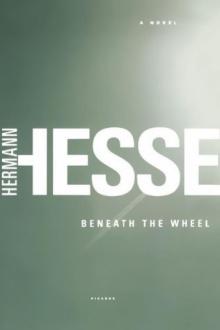 Beneath the Wheel
Beneath the Wheel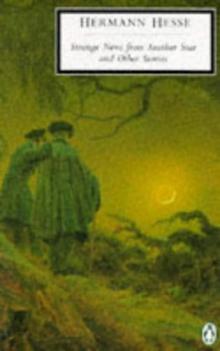 Strange News From Another Star
Strange News From Another Star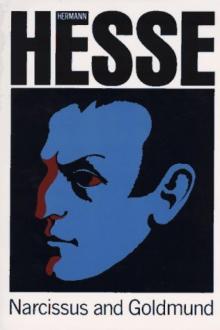 Narcissus and Goldmund
Narcissus and Goldmund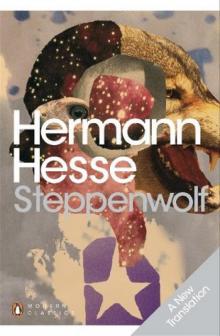 Steppenwolf
Steppenwolf Siddhartha
Siddhartha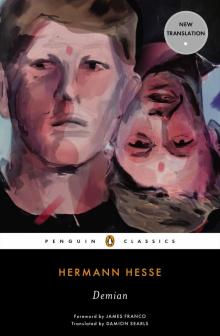 Demian
Demian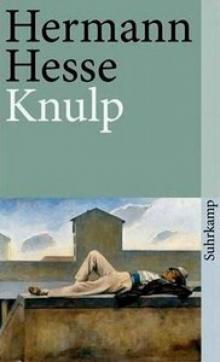 Knulp
Knulp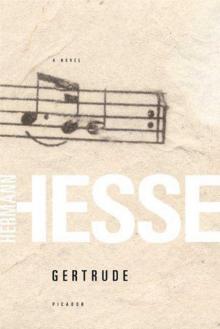 Gertrude
Gertrude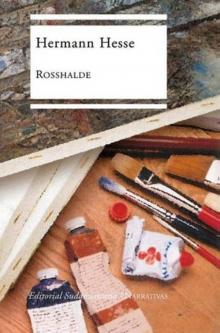 Rosshalde
Rosshalde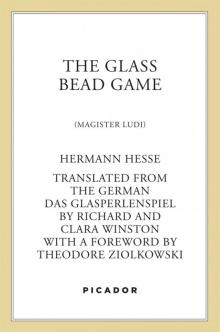 The Glass Bead Game
The Glass Bead Game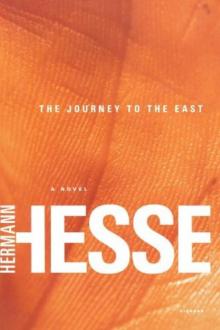 The Journey to the East
The Journey to the East Klingsor's Last Summer
Klingsor's Last Summer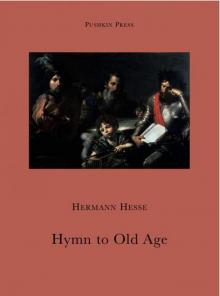 Hymn to Old Age
Hymn to Old Age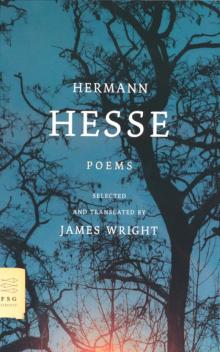 Poems
Poems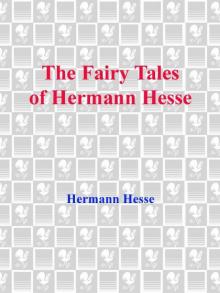 The Fairy Tales of Hermann Hesse
The Fairy Tales of Hermann Hesse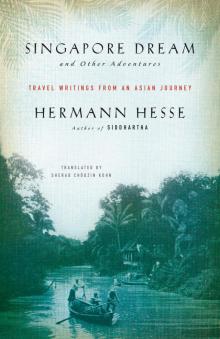 Singapore Dream and Other Adventures
Singapore Dream and Other Adventures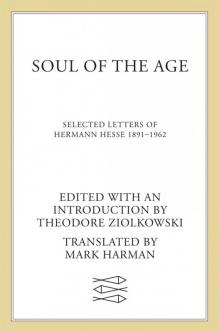 Soul of the Age
Soul of the Age